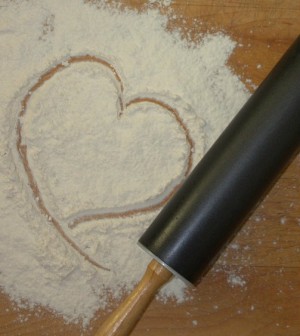- How We Kept Marital Peace while Traveling the World with Our KidsPosted 6 days ago
- How I Coped with Feeling Lost in a Changing SocietyPosted 7 days ago
- The Unexpected Liberation of a Butt DialPosted 1 month ago
- Why is France making abortion a constitutional right?Posted 2 months ago
- Being a WomanPosted 2 months ago
- Grief Threatens To Take Your Power- You Can Get It Back!Posted 2 months ago
20 Tips and Tricks for Gluten-Free Baking

From NaturallySavvy.com
Gluten-free baking can be tricky. Using a store-bought gluten-free flour blend can make things easier than if you try to develop your own blend, but even so, it’s not as simple as substituting all-purpose flour with a gluten-free variety. Many other ingredients used in baking contain gluten, and gluten-free flours react differently with the other ingredients in a recipe. But don’t despair! There are plenty of tips and tricks that can help you master the basics of gluten-free baking.
- Wash your hands before you begin, and make sure you avoid contaminating gluten-free items with ingredients containing gluten if you are baking in a kitchen isn’t gluten-free.
- As with regular baking, make sure you have all ingredients before baking, and bring eggs, milks and butter to room temperature for proper mixing.
- Store your flours or flour blends in the freezer for the freshest products. As with other refrigerated or frozen ingredients, bring the flours to room temperature when baking.
- Use a light hand with your flour blends.
- Look for recipes that are high in moisture to begin with, such as items made with sour cream if it’s a cake, coconut, carrots, zucchini, pumpkin, etc. Breads and cakes that are moist are good options to try to make gluten-free.
- Sugar holds moisture as well, so trying a low sugar recipe might not be the best idea. Natural sweeteners such as turbinado, honey, maple syrup, or sweet ingredients like banana can be used instead.
- Though moisture is important, gluten-free foods can be very gummy if an incorrect ratio is used with the flours or if there is too much moisture. A balance will come with practice and time.
- Xanthan gum is used to add volume, structure, and viscosity when there is no gluten present. It also stabilizes and emulsifies. If too much is used, you’ll get a very gummy product that is sticky, slimy, and heavy. It will lose its gumming properties the longer it is mixed. Xanthan gum is derived from corn, so always look for a non-GMO variety. A different gum, such as guar gum, can be used if corn allergies are an issue.
- Gluten-free batter and dough can be gummier and stickier, so make sure to scrape the sides of your bowl down well as you mix and blend.
- Using an electric mixer is usually preferred over a spoon because you can get a smoother texture and will avoid lumps.
- Properly butter or line pans with parchment to ensure your foods do not stick to baking pans. Cookies work best on a parchment-lined baking sheet.
- Gluten-free items need more leavening, so increase baking powder and baking soda. Don’t forget how baking soda works—it is alkaline and, in your batter, will react with acid ingredients such as buttermilk, sour cream, yogurt, bananas, cocoa, and vinegars.
- Be sure to use a gluten-free baking powder. While you’re at it, check the labels of other ingredients such as vanilla and chocolate chips, as these are not always gluten-free (the same goes for vinegars and mustards in your other cooking and/or baking).
- Increase vanilla and other spices for the best, fullest flavor in your gluten-free baked goods. Find a good gluten-free vanilla and use it liberally.
- Watch out for oats. Although oats are technically gluten-free, cross-contamination with wheat, rye and barley in the fields or the mill may happen, so be sure to purchase oats that are certified gluten-free.
- To replace oats in some recipes, you could experiment with coconut chips (unsweetened and dried) or quinoa flakes for crunch. Puffed rice cereal is also great for bars or cookies for some gluten-free crunch and crisp.
- There are many flours that people forget about trying out, including quinoa flour and coconut flour. Try them out if you’re in baking mode!
- Other gluten-free flour options include: amaranth flour, arrowroot, brown and white rice flour, buckwheat flour, corn meal, chick pea or garbanzo bean flour, potato starch, sorghum flour, tapioca flour or starch, and teff flour. Keep in mind that many of these flours are not ideal to use on their own. Mixing a variety of gluten-free flours together results in a better-tasting product.
- If you include soy in your diet, organic soy flour is a great option due to its higher protein content.
- Potato flour (not potato starch) and millet flour are gluten-free but they do not work well in gluten-free baking.
Be sure to keep a sense of humor, an open mind, and an open palate. Gluten-free baked goods may not taste exactly like your old ones, but they can be just as (or more) delicious as their wheat counterparts. You might not always have success, but experimentation will give you experience. The more you see how ingredients work, the better luck you will have overall.
[Editor’s Note: If you want to learn more about gluten and how to avoid it, click here to sign up for Naturally Savvy’s Gluten-Free Get Healthy Challenge)
“Food should not only be good to eat, but also good to think.” –Claire Fountain
 Claire Fountain is witty, passionate and lives a sweet life of all things food. Claire believes in sharing her knowledge of baking and cooking along side her holistic approach to eating with all of you.
Claire Fountain is witty, passionate and lives a sweet life of all things food. Claire believes in sharing her knowledge of baking and cooking along side her holistic approach to eating with all of you.
As a food writer featured in books and publications, with a background teaching cooking classes, vegan baker and personal chef, to name a few ventures, Claire loves the science, history and lore of food. Recipe development, catering and researching… Claire keeps it joyous in and out of the kitchen.
Though born and raised in Mississippi on biscuits and ranch dressing, she practices what she preaches in her own daily food choices, with taste being at the forefront. She currently writes and bakes in New York; spending time supporting local agriculture, sustainable food and promoting conscious consumption with sexy vengeance.







